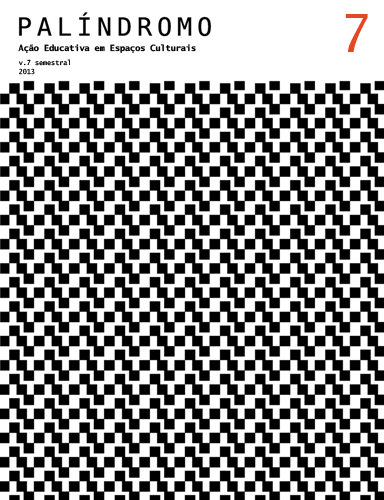Mediação e Ensino da Arte: Um Exercício de Partilha do Sensível
DOI:
https://doi.org/10.5965/2175234604072012006Parole chiave:
Educação estética, Formação dos sentidos humanos, Leitura de imagens, Mediação, Produção e consumo da arteAbstract
Nesse trabalho, pretende-se pensar a educação estética no ensino formal e espaços não escolares partindo do pressuposto de que a produção artística satisfaz a necessidade de expressão de seu criador; porém, enquanto criação para os outros, deve ser compartilhada. Inscreve-se aí o papel do educador em arte: mediador do processo de partilha do sensível ou de apropriação da realidade humano-social também sob a forma de arte. O exercício de mediação – obra, autor, leitores – pode contribuir sobremaneira para tornar visível o significado humano objetivado nas obras de arte. Assim, concebe-se a mediação como um lugar de análise da produção artístico-visual conectando-a as suas condições de produção e apreciação; de produção de novos significados; de distribuição dos bens culturais e, por último, instância de construção de autonomia do aluno na leitura de imagens, processo permanente de significação, de apropriação e de partilha da arte, uma das principais contribuições da educação estética.
Downloads
Riferimenti bibliografici
BOURDIEU, P. A Economia das Trocas Simbólicas. 5 ed. São Paulo: Perspectiva, 1999.
CANCLINI, N. G. A socialização da arte – teoria e prática na América Latina. 2 ed. São Paulo: Cultrix, 1984.
CHARTIER, Roger. A beira da falésia: a história entre certezas e inquietude. Porto Alegre: Universidade, 2002.
CURY, C.J. Educação e Contradição: elementos metodológicos para uma teoria crítica do fenômeno educativo. São Paulo: Cortez, 1985, p.27-28
DAMASCENO, J. Discurso apologético contra os que rejeitam as imagens sagradas. In: LICHTENSTEIN, J. (Org.). A pintura: Textos essenciais. Vol. 2: A teologia da imagem e o estatuto da pintura. São Paulo: Ed. 34, 2004.
FRASCINA, Francis et al. Modernidade e modernismo: a pintura francesa no século XIX. Trad. Tomás Rosa Bueno. São Paulo: Cosac & Naify, 1998.
GARB, Tamar et al. Modernidade e modernismo. A pintura francesa no século XIX. São Paulo: Cosac & Naify, 1998.
HOUAISS, Antônio; VILLAR, Mauro de Salles. Dicionário Houaiss da Língua Portuguesa. Rio de Janeiro: Objetiva, 2001.
KLEIN, L. R. Alfabetização: quem tem medo de ensinar? São Paulo: Cortez; Campo Grande: Ed. Universidade Federal de Mato Grosso do Sul, 1996.
MARIN, Louis. Sublime Poussin. Trad. Mary Amazonas Leite de Barros. São Paulo: Edusp, 2000.
MARX, K. (1857) Introdução para a crítica da economia política. São Paulo: Abril Cultural, 1978. Os Pensadores.
MÉSZÁROS, István. A teoria da alienação em Marx. São Paulo: Boitempo, 2006.
PORCHER, Louis (Org.). Educação artística: luxo ou necessidade? São Paulo: Summus, 1982.
RAMALHO E OLIVEIRA, Sandra. Imagem também se lê. São Paulo: Edições Rosari, 2009.
RANCIÈRE, Jacques. A partilha do sensível: estética e política. São Paulo: Editora 34, 2005.
RANCIÈRE, Jacques. Políticas da escrita. São Paulo: Editora 34, 1995.
SAVIANI, D. Escola e Democracia: teorias da educação, curvatura da vara, onze teses sobre a educação política. Campinas/SP: Autores Associados, 36ª ed., 2003.
THOMPSON, John. B. Ideologia e cultura moderna: teoria social crítica na era dos meios de comunicação de massa. Trad. Grupos de Estudos sobre Ideologia, Comunicação e Representações Sociais da Pós-graduação do Instituto de Psicologia da PUCRS: Carmem Grisci, Jefferson Bernardes, Marcos de O. Müller, Rosana Nora, P. Valério Maia, sob responsabilidade do Prof. Pedrinho A. Guareschi. Rio de Janeiro: Vozes, 1995.
VÁZQUEZ, Adolfo Sanchez. As ideias estéticas de Marx. 2. ed. Rio de Janeiro: Paz e Terra, 1978.
VYGOTSKY, L. Pensamento e Linguagem. São Paulo: Martim Fonte, 1987.
WOLLF, Francis. O poder da imagem. In: NOVAES, Adauto (org.) Muito além do espetáculo. São Paulo.
Downloads
Pubblicato
Come citare
Fascicolo
Sezione
Licenza
Copyright (c) 2013 Consuelo Alcioni Borba Duarte Schlichta, Mauren Teuber

TQuesto lavoro è fornito con la licenza Creative Commons Attribuzione 4.0 Internazionale.
DECLARAÇÃO DE DIREITOS AUTORAIS
a. Os artigos publicados pela revista são de uso gratuito, destinados a aplicações acadêmicas e não comerciais. Todos os direitos autorais são atribuídos à revista. Os artigos cujos autores são identificados representam a expressão do ponto de vista de seus autores e não a posição oficial da Revista Palíndromo. O (s) autor (es) compromete-se sempre que publicar material referente ao artigo publicado no Palíndromo mencionar esta publicação da seguinte forma:
Este artigo foi publicado originalmente pela revista Palíndromo em seu volume (coloque o volume), número (coloque o número) no ano de (coloque o ano) e pode ser acessado em: http://www.revistas.udesc.br/index.php/palindromo
b. Plágio, em todas as suas formas, constitui um comportamento antiético de publicação e é inaceitável. A revista Palíndromo utiliza o software iThenticate de controle de similaridade


